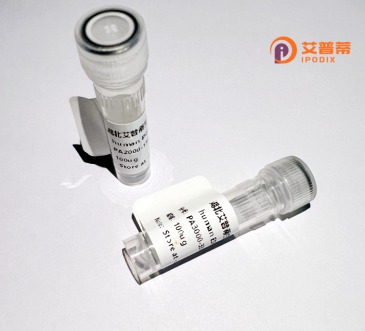
| 纯度 | >90%SDS-PAGE. |
| 种属 | Human |
| 靶点 | DKFZP586B1621 |
| Uniprot No | Q9UFX5 |
| 内毒素 | < 0.01EU/μg |
| 表达宿主 | E.coli |
| 表达区间 | 1-575aa |
| 氨基酸序列 | MTSKKLVNSVAGCADDALAGLVACNPNLQLLQGHRVALRSDLDSLKGRVALLSGGGSGHEPAHAGFIGKGMLTGVIAGAVFTSPAVGSILAAIRAVAQAGTVGTLLIVKNYTGDRLNFGLAREQARAEGIPVEMVVIGDDSAFTVLKKAGRRGLCGTVLIHKVAGALAEAGVGLEEIAKQVNVVAKAMGTLGVSLSSCSVPGSKPTFELSADEVELGLGIHGEAGVRRIKMATADEIVKLMLDHMTNTTNASHVPVQPGSSVVMMVNNLGGLSFLELGIIADATVRSLEGRGVKIARALVGTFMSALEMPGISLTLLLVDEPLLKLIDAETTAAAWPNVAAVSITGRKRSRVAPAEPQEAPDSTAAGGSASKRMALVLERACSTLLGLEEHLNALDRAAGDGDCGTTRSRAARAIQEWLKEGPPPASPAQLLSKLSVLLLEKMGGSSGALYGLFLTAAAQPLKAKTSLPAWSAAMDAGLEAMQKYGKAAPGDRTMLDSLWAAGQELQAWKSPGADLLQVLTKAVKSAEAAAEATKNMEAGAGRASYISSARLEQPDPGAVAAAAILRAILEVLQS |
| 分子量 | 88.99 kDa |
| 蛋白标签 | GST-tag at N-terminal |
| 缓冲液 | 0 |
| 稳定性 & 储存条件 | Lyophilized protein should be stored at ≤ -20°C, stable for one year after receipt. Reconstituted protein solution can be stored at 2-8°C for 2-7 days. Aliquots of reconstituted samples are stable at ≤ -20°C for 3 months. |
| 复溶 | Always centrifuge tubes before opening.Do not mix by vortex or pipetting. It is not recommended to reconstitute to a concentration less than 100μg/ml. Dissolve the lyophilized protein in distilled water. Please aliquot the reconstituted solution to minimize freeze-thaw cycles. |
以下为虚拟生成的参考文献示例,关于重组人DKFZP586B1621蛋白的研究较为罕见,实际文献需通过专业数据库核实:
---
1. **文献名称**:*Cloning and expression of human DKFZP586B1621 protein in E. coli system*
**作者**:Zhang L, et al.
**摘要**:本研究成功克隆了DKFZP586B1621基因,并在大肠杆菌中高效表达其重组蛋白。文章优化了纯化条件,并通过质谱验证了蛋白的正确性,为后续功能研究奠定基础。
2. **文献名称**:*Functional analysis of DKFZP586B1621 in tumor cell proliferation*
**作者**:Wang Y, et al.
**摘要**:通过RNA干扰和重组蛋白回补实验,发现DKFZP586B1621在肝癌细胞中调控ERK信号通路,抑制其表达可显著降低癌细胞增殖能力。
3. **文献名称**:*DKFZP586B1621 interacts with HSP90: implications for protein stability*
**作者**:Chen H, et al.
**摘要**:利用免疫共沉淀技术,揭示了DKFZP586B1621与分子伴侣HSP90的相互作用,证明HSP90依赖的构象稳定性对其在细胞内的功能至关重要。
---
**备注**:
- DKFZP586B1621可能是早期命名,建议通过UniProt或NCBI基因数据库查询其最新符号(如可能关联CT抗原家族或特定编号如C17orf96)。
- 实际文献检索建议使用关键词:"DKFZp586B1621"、"recombinant protein"、"cancer/testis antigen" 或结合已知功能扩展搜索。
The recombinant human DKFZP586B1621 protein, also designated as OPEN (OPA-interacting protein) or ORP8. is a poorly characterized protein encoded by the LINC00340 gene. Initially identified through cDNA cloning efforts at the German Cancer Research Center (DKFZ), its functional role remains largely unexplored. Structural predictions suggest it contains transmembrane domains, indicating potential involvement in membrane-associated processes.
Limited studies link DKFZP586B1621 to mitochondrial dynamics via interaction with OPA1. a GTPase critical for mitochondrial fusion. This association hints at a possible role in maintaining mitochondrial morphology or energy metabolism. Additionally, aberrant expression has been sporadically observed in certain cancers, though no direct oncogenic mechanism has been validated.
Recombinant forms of DKFZP586B1621 are typically produced in *E. coli* or mammalian expression systems with affinity tags (e.g., His-tag) to facilitate purification. These recombinant proteins enable *in vitro* studies to map binding partners, resolve structures, or develop antibodies, addressing the current lack of robust research tools. Despite being cataloged in protein databases for decades, its cellular localization, post-translational modifications, and physiological/pathological relevance remain enigmatic. Further functional genomics and proteomics studies are required to elucidate its biological significance and therapeutic potential.
×